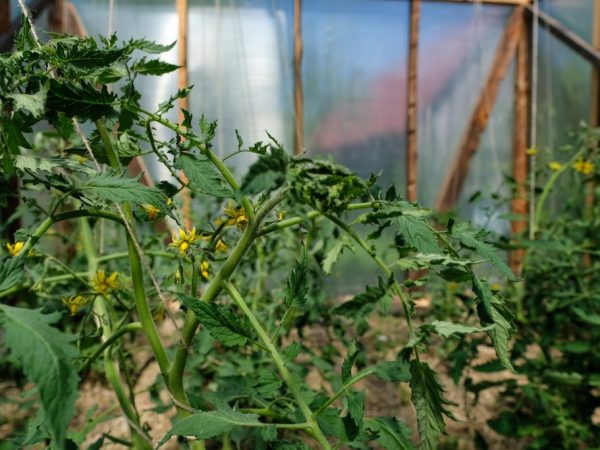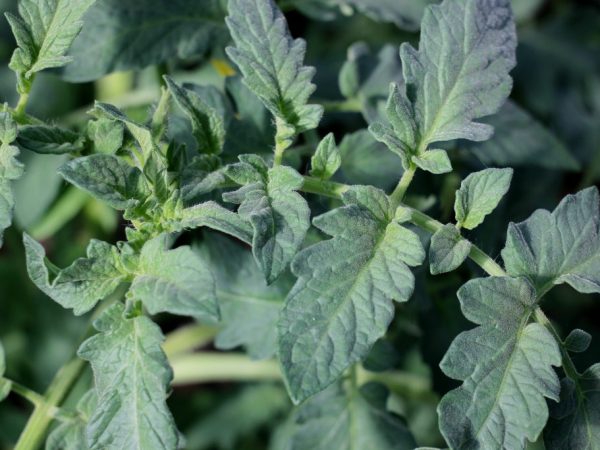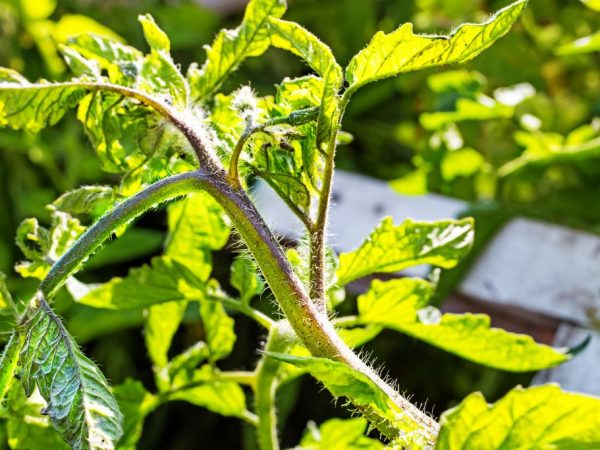Why there is no ovary in tomatoes
When, when growing tomatoes, do not comply with the requirements for soil, moisture, watering, lighting and mineral nutrition, the plants begin, as the gardeners say, “fatten”. This usually leads to a situation where there is no ovary in tomatoes, and, therefore, it is possible not to wait for the harvest.
- What is needed for the ovaries
- Why are they not tied up
- Thermal conditions
- Exceeding thermal performance
- Temperature too low
- Temperature at night
- Humidity level
- Too humid
- Too dry
- Measures
- Mineral nutrition
- Disadvantage
- Overfeeding
- Measures
- Pollination
- Other factors affecting the ovary
- Diseases
- Poor quality seed
- Planting density
- Pinching violation
- Lighting
- Processing of plants for ovaries

Lack of ovaries on tomatoes
What is needed for the ovaries
For the full formation of a tomato ovary when grown in a greenhouse, it is necessary to create the correct microclimate indoors, which involves:
- maintaining the humidity level at 60%,
- ensuring a temperature regime in the range from 21 ° C to 23 ° C,
- compliance with the rules of watering, including carrying out the procedure under the root of plants, completely preventing moisture from entering the stems of a tomato bush and its foliage,
- maintaining the frequency of watering tomato bushes twice per week with abundant moisture,
- performing frequent loosening of the soil in the greenhouse, which will increase the aeration of the earth.
Why are they not tied up
Among the main reasons why tomatoes are not tied in the greenhouse, there may be:
- lack of natural pollination by insects in the greenhouse or improper implementation of artificial pollination,
- insufficiency or excess of mineral nutrition of tomato bushes, improper use of fertilizers in violation of the dosage,
- violation of the order of watering with a lack or excess of moisture,
- lack of sunlight or lack of it,
- improper humidity in the greenhouse,
- incorrectly selected thermal regime.
Thermal regime
Tomatoes react quickly enough to temperature changes. Fluctuations in the indicators on the thermometer often become the reason that tomatoes do not tie in the greenhouse after they bloom.
Exceeding thermal performance
Excessive heat in the greenhouse, when the air warms up to 30 ° C and above, leads to the fact that the pollen on tomato bushes loses its reproductive properties. Such overheating of tomatoes for one day is enough to lose tomato ovaries and lose the harvest of vegetables.
Temperature too low
Lowering the air temperature in the greenhouse during the flowering period of tomato bushes to 15 ° C can also adversely affect the condition of the plants when future tomatoes are not set. Most likely, with such cold air, the plant will suspend its development, without passing the stage of fertilization of inflorescences and the formation of fruits.
Temperature at night
The night time differs in its fluctuations in thermal indicators in the direction of decrease after the daytime heat.Most often, it is at night that tomatoes are exposed to cold air masses, when after a warm day, condensation begins to form on the foliage and stems of plants, and the humidity in the greenhouse rises sharply. Compliance with the optimal indicators on the thermometer and the access of fresh air are important factors affecting the quality of the process of formation of ovaries for tomatoes. If there is not enough heat at night in a greenhouse where vegetables grow, it is recommended to install additional heating sources.
Humidity level

Plant health depends on the nesting of air
Control over the required level of humidity should be provided along with the observation of the thermal regime, since the level of moisture in the greenhouse is the second important factor affecting the formation of fruits in tomatoes.
The level of humidity in the greenhouse determines how healthy your tomato bushes will be and whether vegetables will appear on the tomatoes.
Too humid
An excessive increase in the moisture content of the greenhouse is the reason when the ovary falls off on tomatoes. In the damp ambient air, the inflorescences fall off and will not turn into fruit.
Pollen saturated with excess moisture becomes sticky and does not crumble from the flower anthers, therefore, pollination of the inflorescences does not occur.
Too dry
Excessively dry air in a greenhouse is also an unfavorable situation, leading to the loss of future fruits by plants, since pollen, when it hits the pistil of a female inflorescence, loses its ability to germinate. The tomato crop is capable of maintaining a short drought only after the fruit has set.
Measures
It turns out excess moisture in the greenhouse after the irrigation procedure carried out with the windows closed. As a result, water vapor begins to settle on the stems and foliage of plants, creating a greenhouse effect. To avoid unnecessary condensation, frequent ventilation is required.
It is possible to increase the humidity in the greenhouse and at the same time reduce the ambient degree by cold watering the greenhouse paths. This procedure is done in the first half of the day so that the generated evaporation at night does not lead to a greenhouse effect.
Mineral nutrition
Mineral nutrition of tomatoes should be in moderation, since any deviation from the recommended norms, both upward and downward in the number of fertilized complexes, leads to the fact that there are no ovaries on the tomatoes.
Disadvantage
With a lack of mineral nutrition in a tomato plant, the root system may develop poorly, as evidenced by yellowed foliage, developing rot on the tops of tomato bushes and dropping flowers.
When there is little mineral feeding of varieties of tomatoes that are large and multi-fruited, and when grown in greenhouse does not provide sufficient nutrition for flowers, and as a result, after the past flowering stage, tomatoes do not have a stage of fruit set.
Overfeeding
Many summer residents make a significant mistake, considering an increase in the dose of fertilizers applied as a favorable factor for the growth and development of a vegetable crop. Overfeeding the soil with nitrogen-containing compounds (bird droppings, urea, saltpeter, mullein), gardeners observe tomato seedlings growing stronger and growing before our eyes, which, however, subsequently, with an overgrown leaf mass, does not produce vegetables.
Measures

Excess fertilizer can harm plants
During the transition of the flowering stage of tomato bushes to the formation of ovaries, the amount of nitrogen-containing and potassium compounds introduced should be significantly reduced, which more affect the growth of foliage, rather than serve as an activator of fruit setting. When all the forces of the plant begin to spend on foliage, and the inflorescences are never pollinated:
- temporarily stop watering, ventilate the greenhouse to make the surrounding air dry,
- by foliar and root method, phosphorus-containing complexes are introduced,
- partially remove foliage, especially in places that cover the inflorescences from sunlight.
Pollination
Vegetables grown outdoors are naturally pollinated by wind and insects. When growing a vegetable crop in a greenhouse, the formation of fruits in tomatoes can occur both naturally and artificially. To this end, in warm weather, windows are opened for natural pollination in the greenhouse, thereby providing air access and a draft and opening the way for insects useful in pollination, and at cold temperatures they turn to artificial pollination methods.
Flowers-honey plants placed in the greenhouse allow attracting insects to the greenhouse.
During the artificial method of pollination, in the absence of set fruits, the pollen is spread by shaking the inflorescences or simply knocking on the stems of the plant. This is done in the morning. Some summer residents in a greenhouse create an artificial wind by installing a fan in the room, moving it to different places in the room.
The fact that the pollination of the female inflorescence has occurred can be observed by the arrangement of the petals: on the pollinated flower, the petals open and deviate backward.
You can also pollinate tomato inflorescences using the manual method using a simple brush with soft bristles, transferring pollen from the male flowers to the pistil of the female inflorescence.
After the artificial pollination process has been carried out, it is recommended to create the required humidity. This can be done by spraying water from a spray bottle and watering and spraying tomato bushes.
Other factors affecting the ovary
When all other microclimate conditions in the greenhouse are observed at the proper level, other factors may act as secondary reasons for the fact that tomatoes are not set.
Diseases
Many diseases of tomatoes lead to the fact that the plant does not set a flower or it subsequently sheds it. In some cases, the use of chemical treatment by summer residents at the flowering stage leads to the fact that the fruits of tomatoes are not formed. Therefore, during the period of the appearance of the first inflorescences, it is recommended to do with folk remedies and not to use chemicals.
In case of existing cases of the disease of some tomato bushes, they should be removed completely, since the tomato crop is poorly treated, and the disease in a closed greenhouse spreads to healthy plants too quickly.
Poor quality seed
Seed material can cause the tomatoes to fail to produce fruit. Self-harvested seeds often do not yield, and hybrid varieties of tomatoes are practically not grown from seed.
Planting density
With densely planted tomato bushes, the path to the inflorescences for insects pollinating the plants is blocked and the process of airing the greenhouse slows down. For the full-fledged formation of fruits on tomatoes, it is advisable to plant a vegetable crop so that a distance of at least 0.3-0.45 m remains between the bushes.
Pinching violation
An untimely pinching procedure is one of the secondary reasons why tomatoes do not set fruits. It is done at intervals of every 1-2 weeks, removing excess lateral shoots that take mineral nutrition and strength from the plant and prevent future vegetables from developing.
Lighting
In the case when the greenhouse structure is covered with a film, which has low light transmittance, the lack of sunlight affects the development of fruits in tomatoes. At the same time, a tomato located in the shade not only does not have ovaries, without light, the plant can completely die.
Processing of plants for ovaries
To provoke the formation of ovaries in tomatoes and increase the yield of vegetable crops, you can resort to processing plants at the flowering stage with various active preparations - stimulants, prepared with the necessary components.
- One of these formulations useful for the formation of ovaries, which can be used to process tomatoes for an ovary, is a mixture of boric acid with water in a proportion of 10 g per 10 liters.
- To increase the activity of setting tomato fruits in the absence of ovaries, it is possible if the bushes are treated when they bloom using a superphosphate extract made from 3 large spoons of superphosphate and a liter volume of water. Such an aqueous mixture is infused for two days, with constant stirring. Such a superphosphate fertilizer is applied, 1 liter at the root.
- The phosphate complex, which contains 50% phosphorus and 40% potassium, helps to speed up the development of ovaries. This powder is readily soluble in water and ready to use. They are sprayed with tomato bushes
Ready-made preparations - stimulants improve the process of ovary appearance:
- Ovary and Bud - they contain an active substance of plant origin, gibberellin, which affects budding and fruit formation,
- Tomato and Pollen are powdered preparations that stimulate the formation of tomato ovaries and further fruit formation.


